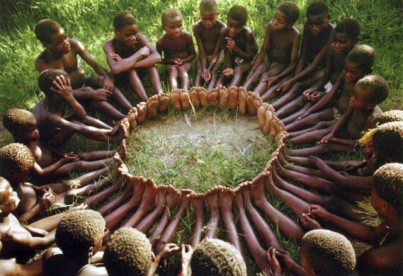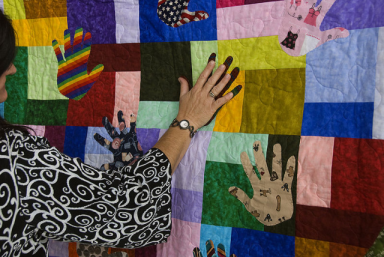Teachers at Northfield Mount Hermon met this week to work through concerns about equity and justice raised by our faculty of color. While at times difficult, the honest conversation opened up some previously blocked avenues for healing. I wrote the following as a continuation of that conversation.
Hello all.
I’m very glad that I came in for our faculty meeting yesterday so that I could listen to and learn from our conversations there. I especially appreciate the courage of you who spoke honestly about ways in which you’ve felt hurt, isolated, or underappreciated. That takes guts—and your courage impels us all to take further responsibility for building the community and school we intend. I’ve been thinking about our meeting since then and hope that sharing some of those thoughts here contributes to more discussion.
A few years ago, I attended an alumni function at the Wheeler School in Providence, Rhode Island.[1] It caught my attention to see and hear that the school now frames its multicultural programs under the heading of “Unity and Diversity.” Though I’ve taken part in many multicultural trainings and worked hard to investigate and challenge my own considerable levels of privilege—I grew up male, white, heterosexual, educated, middle-class Christian—I’d never heard those two words linked so directly and so intentionally. The combination conveys an elegant truth I’d previously only felt: both diversity and unity are crucial components of full humanness. Calling for one without the other, I notice, activates a kind of defensiveness. I don’t want to have to give up or ignore either of the pair.
I long—and I trust that we all long—for some measure of unity. We thirst for connection, we yearn for belonging, and we seek shared experiences that stitch us together. We find untapped reserves of resolution and resilience when we have a common purpose. When we’re a part of an effective team, we accomplish far more than we could on our own. Athletes working in unison in the heat of competition, musicians finding the sweet spot of harmony, different folks pulling in the same workplace direction: they all generate significant joy and achievement.
I also know that we thrive when we can recognize and celebrate our differences. Each of us brings a unique perspective to any situation. Bringing out those multiple perspectives adds richness, vitality, flavor, and color. Our worldviews open up to wider vistas. As is true in any ecosystem, greater diversity increases our resilience to threats from outside. You can see and respond to threats that I cannot—and I offer the same for your blind or weak spots in return. We harness the difference in diversity and reach creative combinations that otherwise remain impossible. Faulty assumptions get corrected. The alloy strengthens the steel.
The tricky part comes in finding the right balance. Promoting diversity without a conscious effort toward unity can lead to a splintering that furthers distance and isolation. It can calcify resentment and fear—why are they getting privileges? what about my suffering? they can’t possibly understand what it’s like!—and foster self defeating hesitation—will I misstep? will they mock me? why would they want me to join them?

Unity programs with no political awareness can actually serve to whitewash over important differences.
…..
Courtesy of Wikimedia Commons.
Likewise, promoting unity without a full accounting for diversity can cause more harm than good, encouraging superficial smiles to whitewash histories of real division and pain. Calls for unity can morph into demands for conformity, especially destructive when the required conforming means having to adhere to a dominant ideal or privilege paradigm. “Can’t we all get along?” asks the naïve-to-racism white person, not realizing that the ‘getting along’ they suggest includes hopping on board with a white cultural, emotional, and interpersonal standard.
It’s important that this work addresses such deeper political questions head-on. As one colleague noted when she and I processed the meeting afterwards, maybe we should bypass calling this work “diversity” and instead go directly for “social justice and equity” instead. It’s not just the differences that matter. Yes, honoring and celebrating difference is good. But we also need to name and undo the institutional structures and systems that codify and replicate inequalities based on those differences. Such power injustice may not be intentional. That makes it no less real.
Take this very meeting, for a subtle example. We were encouraged by an intelligent, well-meaning white faculty member to use a Quaker-style approach to our conversation: we stay quiet until feeling moved to speak, then one person at a time stands to share. In that mode together, we’d find a collective wisdom rather than engage in a debate or a dialogue. Lord knows, I go all in with such ritual forms. Quakers have developed a powerful ‘technology’ for talking about what really matters and for discerning shared wisdom (though it should be noted that any Quaker Meeting would be a religious meeting designed to find Spirit’s leading). They also have long demonstrated a commitment to social justice concerns. In this case, the format worked to create what seemed like a valuable conversation. That said, it’s also still an exceedingly white form.
An African-American church, in contrast, might employ a call-and-response format. In that setting, silence between speakers would indicate lack of resonance or even disagreement. The meeting would lack life rather than demonstrate respect. By choosing the approach we did—and without naming it as a white approach or explaining its benefits—we unwittingly offered a conversational advantage to those more likely to be familiar with it. A subtle advantage, perhaps, but again, it’s a real one. I wonder if some felt silenced rather than welcomed by the form.
The ideal would simultaneously promote two fundamental and paradoxical truths: we are each unique—a singular combination of identities and affinities—and we’re also interconnected, radically interwoven into one grand whole. Unity and diversity work can rise together like a double helix, always turning into and around each other.
Or perhaps they can form a Möbius strip, one actually leading directly into the other.

A Möbius strip crafted with a piece of paper and tape. If one side is Unity and other Diversity, you can walk both paths just by moving forward.
…..
Courtesy of Wikimedia Commons
In that way, we’d find and build an active, engaged, vital diversity that serves a larger totality. At the same time, we’d develop a unity that thrived on the gifts and perspectives of every individual.
How do we make all this happen then? What tangible steps can we take? I can think of at least five.
- As institutions and individuals, we can begin telling our truthful stories. The vulnerability of honesty is a real risk: if you know about my tender places, you can hurt me. I have to figure out how to take that risk, though: it’s a necessary step for building connection.
- We can assume positive intentions. The various smogs of oppression—racism, sexism, homophobia, and the rest—have poisoned and blinded us. But we aren’t born with hate in our hearts. Speaking to the positive core in others softens defenses and builds generosity.
- We can work to earn that assumption. Actions do more to engender trust than words do. Those of us who attend a diversity conference, bring a different perspective into the curriculum, or even sit at a new table make tangible our commitment to healing past hurts and building a diversity-welcoming unity. We embody our intention.
- We can take the risk of failing—and then be willing to forgive ourselves and others for those failures. Walls of injustice won’t fall under hesitant dismantling. Only bold authenticity will break the barriers down. Call each other out on the occasional hurts and offenses, yes—that’s part of how we learn—but do so in a spirit of generosity and resilience.
- We can shift our language. When we talk about diversity, we can offer a nod to unity. When we promote unity, we can remember our difference. Doing so prevents any reflexive defensiveness or dismissal that results from having one of the elements ignored or devalued.
Take these thoughts as you will, one man’s (one white, educated, heterosexual, middle-class man’s) beginning reflections on a profoundly complex and important topic. I’d be delighted to hear your thoughts in return.
[1] Though I graduated from a different high school, my middle school years at Wheeler proved formative enough that I still consider myself an alum.






Fine thoughtful piece, Ted! Thanks for sharing.
David
And thank you for reading, D.
Ted, you are raising some really valuable points. Your observations on choosing the quaker style are right on target. And is the white faculty able to hear what the faculty of color was bringing to the table? And is the faculty of color willing to look at the fact that *hurt, isolated and underappreciated * still reflects a style of being less than. Where is the anger and the willingness to name the racism? Where is the space to speak the truth of what those words really mean.
And are you as a white, educated, heterosexual, privileged male willing to stand with those people of color and name the reality of what Mt. Hermon represents?
*Complex* doesn’t come close to describing the depth of the issues.
Hello, Kathleen, and thanks for sharing your thoughts.
I think, yes, the white faculty did listen carefully and many were even quite moved. One long-time member of the faculty realized that he has promoted a blind kind of unity in the past–“deep down, we’re all the same”–and now can see how reiterating that sentiment (even if it’s true on some level) without acknowledging diversity smooths over the real pain that others have felt and continue to feel. Some of us white faculty members will convene to work on such issues on our own, finding ways to contribute so that the faculty of color don’t have the primary burden of waking us up.
I’m cautious about naming any *single* reality that the school represents. As we discussed in the meeting, NMH has a long history of commitment to inclusion and diversity–and like most private boarding schools in the Northeast, we’re also a bastion of privilege, subject to deep and subtle currents of racism, sexism, classism and the like.
I’m so thankful for my colleagues for taking the risk of speaking some truth.
Hi Ted,
Thank you for writing this. I’m grateful to the folks of colour in your faculty for initiating the dialogue. I think you are right on the money in examining which voices are empowered or inadvertently suppressed by the mainstream framing and your institution’s practice of exploring the issue. As a white person my opinion is only partly helpful and so I suggest that how your colleagues of colour respond is the most important thing. I especially wonder how they felt about the Quaker format that was used.
Did we speak about this book? http://www.amazon.com/Power-Love-Theory-Practice-Social/dp/1605093041#reader_1605093041 I lost my copy – hey maybe I gave it to you – and through your post you have prompted me to order another one. It very much corresponds to your double helix symbol.
Martin Luther King Jr. had his version of this truth when he said, “Power without love is reckless and abusive, and love without power is sentimental and anemic. Power at its best is love implementing the demands of justice, and justice at its best is power correcting everything that stands against love.”
Thank you thank you. Keep going. 🙂
Toby
Thanks for your reflections, Toby. What a beautiful quotation from Dr. King–spot on, the kind of double helix “yes-and” combination I was trying to convey. I’ll try to find that book you recommend. It looks like it would be right up my alley.
Hope all’s well where you are!